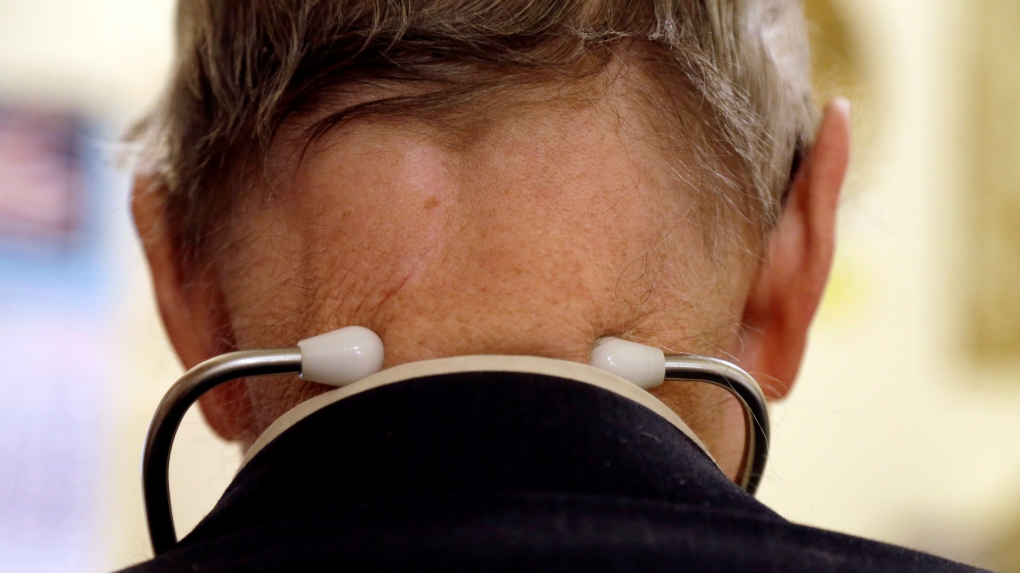'My family doctor just fired me': Ontario patients frustrated with de-rostering
Dozens of Ontarians are expressing frustration in the province’s health-care system after their family doctors either dropped them as patients or threatened to after they sought urgent care elsewhere.
Nearly 100 people contacted CTV News Toronto over several days in response to a callout for personal experiences with the process known as “de-rostering.”
Many said that they had no idea that they could be dropped as patients and only found out about it after they visited another clinic for care.
Ottawa resident Ashley Desrochers said that in mid-January she made the decision to visit an after-hours clinic for urgent care after her legs started to severely swell. Her family doctor agreed to see her, she said, but had no availabilities for about two months.
She decided to go to a walk-in facility associated with her primary care provider, and while there she saw her own family doctor – who promptly gave her an appointment a few days later.
However, she said that her doctor warned her that if she had seen any other doctor while at the other clinic, he would be charged.
“If I were to go to the clinic again, he would release me as a patient, even though this was the first time I had access the clinic for the year,” Desrochers said. “That took me aback. I know that doctors need to be paid for their time, and they can't afford to have their patients go somewhere else. But when we're in a situation where we need to see our doctor and we can't see our doctor, we have no other choice than to go somewhere else.”
Many of the people who contacted CTV News Toronto expressed concern over de-rostering threats, though the majority were not ultimately dropped as patients.
In one instance, an individual suffering from mental health challenges said she chose to book a virtual appointment for an assessment and prescription over a weekend. She said that at her next appointment with her family physician, she was informed that if she went to someone else for care, she could be de-rostered.
The parent of a 15-year-old wrote in to say that her child received care while away at a summer camp five hours away from where their family doctor’s office was located. She was removed from her family doctor’s patient list upon her return.
Jennie Carr from Mississauga told CTV News Toronto her doctor sent her a letter after she took her teenage son, who suffers from seasonal strep, to a walk-in clinic for antibiotics. She said she was unable to make an appointment for that day.
“I received an email from my doctor scolding me for taking my son to a walk-in clinic because they get billed when you take them to a walk-in clinic and out of respect for my relationship with my doctor, I should wait until he has availability and if it’s an emergency we should take him to an emergency room,” Carr said.
 Jennie Carr from Mississauga says she was threatened with de-rostering after taking her son to a walk-in clinic. (Provided)
Jennie Carr from Mississauga says she was threatened with de-rostering after taking her son to a walk-in clinic. (Provided)
Carr has since found a new primary care provider.
Many of the responses were from patients seeking care elsewhere out of either urgent need or convenience for minor ailments.
North York resident Edward Chan, 36, said that a couple of years ago he chose to see a doctor virtually to get orthotics, as he knew it could take a while to get an appointment with his primary care provider.
“It's a nightmare trying to book an appointment. And even when you get to the appointment, you're waiting a long, long time before you get to see him,” Chan told CTV News Toronto. “I figured something like this didn’t really need that much time.”
Within 20 minutes he had his prescription. But when he needed to book his annual physical with his family doctor, he was told by the receptionist that he had been de-rostered. Eventually he learned it was due to his decision to seek care elsewhere.
“I joked around with my friends and family and I told them, my family doctor just fired me,” Chan said. “How can this happen in Canada?”
Chan says he doesn’t blame his family doctor, noting he has seen his primary care provider for over 30 years. Rather he is angry at the system in place.
“We shouldn't need to go to them for the littlest things like sick notes and prescription,” he said. “The fact that the family doctors, they get punished for this, and then we get punished for doing that. It's ridiculous.”
Why does this happen?
Family doctors in Ontario are paid using a variety of systems. Some operate under a fee-for-service model, in which they are reimbursed under the Ontario Health Insurance Plan (OHIP) for every service they provide a patient. The other is an enrollment system, in which doctors are paid per patient, regardless of how many times they see them.
 A doctor wears a stethoscope around his neck as he tends to patients in his office in Illinois on Tuesday, Oct. 30, 2012. THE CANADIAN PRESS/AP, Jeff Roberson
A doctor wears a stethoscope around his neck as he tends to patients in his office in Illinois on Tuesday, Oct. 30, 2012. THE CANADIAN PRESS/AP, Jeff Roberson
However, under the enrolment or rostered system, every time that patient seeks care elsewhere, the family physician is deducted part of the available funding.
“It ranges anywhere from 50 to 100 per cent (of the fee),” Toronto Dr. Fred Freedman told CTV News Toronto.
Freedman says the rostered system is beneficial, as it allows doctors to provide care without worrying about the dollar amount attached. However, he added it also means the Ministry of Health deems it a “failure” if they can’t meet the 24/7 needs of a patient.
“We commit to providing all the internal practice services to everybody on our roster. But it does not prohibit people on our roster from going anywhere to get their primary care, and it's deemed a failure of our practice, of any roster practice, if a patient goes somewhere else,” he said.
“So we have to be there whenever they want care, but if they decide to go somewhere else, that's their business and we have to pay for it.”
According to the Ministry of Health, there were more than 5,800 family physicians enrolled in a Family Health Organization as of 2022.
Another 2,500 are part of a Family Health Group, 224 are part of a Family Health Network, and just over 1,600 family physicians work under the fee-for-service system.
“Patients enrolled with a family doctor should always seek treatment there first, however, should they require immediate care, and cannot access the family doctor, they can seek care in any primary care setting, such as a walk-in clinic,” a spokesperson for the Minister of Health said in a statement. “Should they need to visit a walk-in, patients are always encouraged to follow-up with the family doctor afterwards.”
“In certain circumstances, when a patient receives care from more than one health care provider, an enrolling physician may decide to de-enroll a patient, but can continue to provide services to the patient on a fee-for-service basis.”
The government says the deductions are from “a potential bonus payment that can be earned by the enrolling group.” The ministry says it does not impact the physician’s base pay.
The ministry says that bonuses and premiums account for 10 per cent of a physician’s compensation.
CTVNews.ca Top Stories

Dangerous brew: Ocean heat and La Nina combo likely mean more Atlantic hurricanes this summer
Get ready for what nearly all the experts think will be one of the busiest Atlantic hurricane seasons on record, thanks to unprecedented ocean heat and a brewing La Nina.
Was this the bug that stung you? Wasp sightings revive murder-hornet concerns; no detections confirmed
As temperatures rise out of a mild El Nino winter, Canada's buggy season is already upon us again, and this year, the bugs are looking especially big.
New bill would let Canadians to pass citizenship rights down to children born abroad
A new government bill tabled in the House of Commons on Thursday would allow Canadians to pass citizenship rights down to their children born outside the country — a move that would add an unknown number of new citizens.
Potential tornado 'surreal' for residents who witnessed damaging storm in southern Ontario
Witnessing a potential tornado was 'surreal' for residents who caught a glimpse of the damaging storm in southern Ontario on Wednesday night.
Hundreds have applied for this 'adventurer' job in Banff National Park
Coined as Banff's 'ultimate summer job,' the Moraine Lake Bus Company says hundreds of people from across the world have applied for its adventurer position.
'We'll need all hands on deck': Details emerge after deadly boat crash near Kingston, Ont.
Police say they have wrapped up their on-scene investigation into a deadly boat crash in eastern Ontario as details of the incident begin to emerge.
'Looking over our shoulders': A killing looms large in a little B.C. town
Something shifted in the pretty little village of Lumby, B.C., after Tatjana Stefanski vanished.
WestJet planning new fare category for travellers willing to forgo carry-on bag
WestJet Airlines plans to launch a new cheaper fare category that would be available to travellers willing to fly without a carry-on bag.
Jennifer Lopez's response to question about Ben Affleck is a reminder of their decades of love in the spotlight
Plenty of people are wondering if Jennifer Lopez and Ben Affleck are having problems in their marriage, but one person had the nerve to ask in a public forum.


































